Orthogonal polynomials¶
An orthogonal polynomial sequence is a sequence of polynomials  of degree
of degree  , which are mutually orthogonal in the sense that
, which are mutually orthogonal in the sense that

where  is some domain (e.g. an interval
is some domain (e.g. an interval ![[a,b] \in \mathbb{R}](../_images/math/3b76e28a88e5404196d7722767713b9ba940020a.png) ) and
) and  is a fixed weight function. A sequence of orthogonal polynomials is determined completely by
is a fixed weight function. A sequence of orthogonal polynomials is determined completely by  ,
,  , and a normalization convention (e.g.
, and a normalization convention (e.g.  ). Applications of orthogonal polynomials include function approximation and solution of differential equations.
). Applications of orthogonal polynomials include function approximation and solution of differential equations.
Orthogonal polynomials are sometimes defined using the differential equations they satisfy (as functions of  ) or the recurrence relations they satisfy with respect to the order
) or the recurrence relations they satisfy with respect to the order  . Other ways of defining orthogonal polynomials include differentiation formulas and generating functions. The standard orthogonal polynomials can also be represented as hypergeometric series (see Hypergeometric functions), more specifically using the Gauss hypergeometric function
. Other ways of defining orthogonal polynomials include differentiation formulas and generating functions. The standard orthogonal polynomials can also be represented as hypergeometric series (see Hypergeometric functions), more specifically using the Gauss hypergeometric function  in most cases. The following functions are generally implemented using hypergeometric functions since this is computationally efficient and easily generalizes.
in most cases. The following functions are generally implemented using hypergeometric functions since this is computationally efficient and easily generalizes.
For more information, see the Wikipedia article on orthogonal polynomials.
Legendre functions¶
legendre()¶
- mpmath.legendre(n, x)¶
legendre(n, x) evaluates the Legendre polynomial
 .
The Legendre polynomials are given by the formula
.
The Legendre polynomials are given by the formula
Alternatively, they can be computed recursively using

A third definition is in terms of the hypergeometric function
 , whereby they can be generalized to arbitrary
, whereby they can be generalized to arbitrary  :
:
Plots
# Legendre polynomials P_n(x) on [-1,1] for n=0,1,2,3,4 f0 = lambda x: legendre(0,x) f1 = lambda x: legendre(1,x) f2 = lambda x: legendre(2,x) f3 = lambda x: legendre(3,x) f4 = lambda x: legendre(4,x) plot([f0,f1,f2,f3,f4],[-1,1])
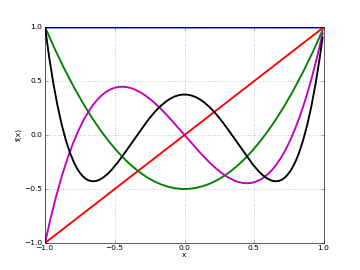
Basic evaluation
The Legendre polynomials assume fixed values at the points
 and
and  :
:>>> from mpmath import * >>> mp.dps = 15; mp.pretty = True >>> nprint([legendre(n, 1) for n in range(6)]) [1.0, 1.0, 1.0, 1.0, 1.0, 1.0] >>> nprint([legendre(n, -1) for n in range(6)]) [1.0, -1.0, 1.0, -1.0, 1.0, -1.0]
The coefficients of Legendre polynomials can be recovered using degree-
 Taylor expansion:
Taylor expansion:>>> for n in range(5): ... nprint(chop(taylor(lambda x: legendre(n, x), 0, n))) ... [1.0] [0.0, 1.0] [-0.5, 0.0, 1.5] [0.0, -1.5, 0.0, 2.5] [0.375, 0.0, -3.75, 0.0, 4.375]
The roots of Legendre polynomials are located symmetrically on the interval
![[-1, 1]](../_images/math/5c3818b9565a33fd3aadba10026d32c5e3eea90f.png) :
:>>> for n in range(5): ... nprint(polyroots(taylor(lambda x: legendre(n, x), 0, n)[::-1])) ... [] [0.0] [-0.57735, 0.57735] [-0.774597, 0.0, 0.774597] [-0.861136, -0.339981, 0.339981, 0.861136]
An example of an evaluation for arbitrary
 :
:>>> legendre(0.75, 2+4j) (1.94952805264875 + 2.1071073099422j)
Orthogonality
The Legendre polynomials are orthogonal on
![[-1, 1]](../_images/math/5c3818b9565a33fd3aadba10026d32c5e3eea90f.png) with respect
to the trivial weight
with respect
to the trivial weight  . That is,
. That is,  integrates to zero if
integrates to zero if  and to
and to  if
if  :
:>>> m, n = 3, 4 >>> quad(lambda x: legendre(m,x)*legendre(n,x), [-1, 1]) 0.0 >>> m, n = 4, 4 >>> quad(lambda x: legendre(m,x)*legendre(n,x), [-1, 1]) 0.222222222222222
Differential equation
The Legendre polynomials satisfy the differential equation

We can verify this numerically:
>>> n = 3.6 >>> x = 0.73 >>> P = legendre >>> A = diff(lambda t: (1-t**2)*diff(lambda u: P(n,u), t), x) >>> B = n*(n+1)*P(n,x) >>> nprint(A+B,1) 9.0e-16
legenp()¶
- mpmath.legenp(n, m, z, type=2)¶
Calculates the (associated) Legendre function of the first kind of degree n and order m,
 . Taking
. Taking  gives the ordinary
Legendre function of the first kind,
gives the ordinary
Legendre function of the first kind,  . The parameters may be
complex numbers.
. The parameters may be
complex numbers.In terms of the Gauss hypergeometric function, the (associated) Legendre function is defined as

With type=3 instead of type=2, the alternative definition

is used. These functions correspond respectively to LegendreP[n,m,2,z] and LegendreP[n,m,3,z] in Mathematica.
The general solution of the (associated) Legendre differential equation

is given by
 for arbitrary constants
for arbitrary constants
 ,
,  , where
, where  is a Legendre function of the
second kind as implemented by legenq().
is a Legendre function of the
second kind as implemented by legenq().Examples
Evaluation for arbitrary parameters and arguments:
>>> from mpmath import * >>> mp.dps = 25; mp.pretty = True >>> legenp(2, 0, 10); legendre(2, 10) 149.5 149.5 >>> legenp(-2, 0.5, 2.5) (1.972260393822275434196053 - 1.972260393822275434196053j) >>> legenp(2+3j, 1-j, -0.5+4j) (-3.335677248386698208736542 - 5.663270217461022307645625j) >>> chop(legenp(3, 2, -1.5, type=2)) 28.125 >>> chop(legenp(3, 2, -1.5, type=3)) -28.125
Verifying the associated Legendre differential equation:
>>> n, m = 2, -0.5 >>> C1, C2 = 1, -3 >>> f = lambda z: C1*legenp(n,m,z) + C2*legenq(n,m,z) >>> deq = lambda z: (1-z**2)*diff(f,z,2) - 2*z*diff(f,z) + \ ... (n*(n+1)-m**2/(1-z**2))*f(z) >>> for z in [0, 2, -1.5, 0.5+2j]: ... chop(deq(mpmathify(z))) ... 0.0 0.0 0.0 0.0
legenq()¶
- mpmath.legenq(n, m, z, type=2)¶
Calculates the (associated) Legendre function of the second kind of degree n and order m,
 . Taking
. Taking  gives the ordinary
Legendre function of the second kind,
gives the ordinary
Legendre function of the second kind,  . The parameters may
complex numbers.
. The parameters may
complex numbers.The Legendre functions of the second kind give a second set of solutions to the (associated) Legendre differential equation. (See legenp().) Unlike the Legendre functions of the first kind, they are not polynomials of
 for integer
for integer  ,
,  but rational or logarithmic
functions with poles at
but rational or logarithmic
functions with poles at  .
.There are various ways to define Legendre functions of the second kind, giving rise to different complex structure. A version can be selected using the type keyword argument. The type=2 and type=3 functions are given respectively by

where
 and
and  are the type=2 and type=3 Legendre functions
of the first kind. The formulas above should be understood as limits
when
are the type=2 and type=3 Legendre functions
of the first kind. The formulas above should be understood as limits
when  is an integer.
is an integer.These functions correspond to LegendreQ[n,m,2,z] (or LegendreQ[n,m,z]) and LegendreQ[n,m,3,z] in Mathematica. The type=3 function is essentially the same as the function defined in Abramowitz & Stegun (eq. 8.1.3) but with
 instead
of
instead
of  , giving slightly different branches.
, giving slightly different branches.Examples
Evaluation for arbitrary parameters and arguments:
>>> from mpmath import * >>> mp.dps = 25; mp.pretty = True >>> legenq(2, 0, 0.5) -0.8186632680417568557122028 >>> legenq(-1.5, -2, 2.5) (0.6655964618250228714288277 + 0.3937692045497259717762649j) >>> legenq(2-j, 3+4j, -6+5j) (-10001.95256487468541686564 - 6011.691337610097577791134j)
Different versions of the function:
>>> legenq(2, 1, 0.5) 0.7298060598018049369381857 >>> legenq(2, 1, 1.5) (-7.902916572420817192300921 + 0.1998650072605976600724502j) >>> legenq(2, 1, 0.5, type=3) (2.040524284763495081918338 - 0.7298060598018049369381857j) >>> chop(legenq(2, 1, 1.5, type=3)) -0.1998650072605976600724502
Chebyshev polynomials¶
chebyt()¶
- mpmath.chebyt(n, x)¶
chebyt(n, x) evaluates the Chebyshev polynomial of the first kind
 , defined by the identity
, defined by the identity
The Chebyshev polynomials of the first kind are a special case of the Jacobi polynomials, and by extension of the hypergeometric function
 . They can thus also be
evaluated for nonintegral
. They can thus also be
evaluated for nonintegral  .
.Plots
# Chebyshev polynomials T_n(x) on [-1,1] for n=0,1,2,3,4 f0 = lambda x: chebyt(0,x) f1 = lambda x: chebyt(1,x) f2 = lambda x: chebyt(2,x) f3 = lambda x: chebyt(3,x) f4 = lambda x: chebyt(4,x) plot([f0,f1,f2,f3,f4],[-1,1])
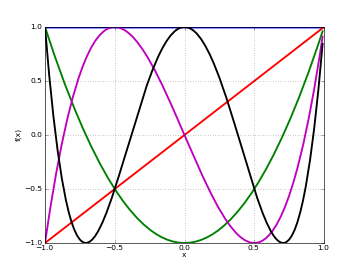
Basic evaluation
The coefficients of the
 -th polynomial can be recovered
using using degree-
-th polynomial can be recovered
using using degree- Taylor expansion:
Taylor expansion:>>> from mpmath import * >>> mp.dps = 15; mp.pretty = True >>> for n in range(5): ... nprint(chop(taylor(lambda x: chebyt(n, x), 0, n))) ... [1.0] [0.0, 1.0] [-1.0, 0.0, 2.0] [0.0, -3.0, 0.0, 4.0] [1.0, 0.0, -8.0, 0.0, 8.0]
Orthogonality
The Chebyshev polynomials of the first kind are orthogonal on the interval
![[-1, 1]](../_images/math/5c3818b9565a33fd3aadba10026d32c5e3eea90f.png) with respect to the weight
function
with respect to the weight
function  :
:>>> f = lambda x: chebyt(m,x)*chebyt(n,x)/sqrt(1-x**2) >>> m, n = 3, 4 >>> nprint(quad(f, [-1, 1]),1) 0.0 >>> m, n = 4, 4 >>> quad(f, [-1, 1]) 1.57079632596448
chebyu()¶
- mpmath.chebyu(n, x)¶
chebyu(n, x) evaluates the Chebyshev polynomial of the second kind
 , defined by the identity
, defined by the identity
The Chebyshev polynomials of the second kind are a special case of the Jacobi polynomials, and by extension of the hypergeometric function
 . They can thus also be
evaluated for nonintegral
. They can thus also be
evaluated for nonintegral  .
.Plots
# Chebyshev polynomials U_n(x) on [-1,1] for n=0,1,2,3,4 f0 = lambda x: chebyu(0,x) f1 = lambda x: chebyu(1,x) f2 = lambda x: chebyu(2,x) f3 = lambda x: chebyu(3,x) f4 = lambda x: chebyu(4,x) plot([f0,f1,f2,f3,f4],[-1,1])
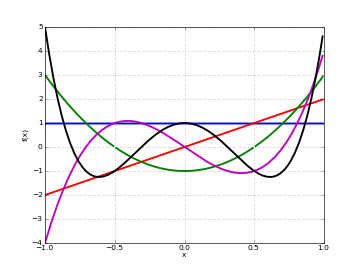
Basic evaluation
The coefficients of the
 -th polynomial can be recovered
using using degree-
-th polynomial can be recovered
using using degree- Taylor expansion:
Taylor expansion:>>> from mpmath import * >>> mp.dps = 15; mp.pretty = True >>> for n in range(5): ... nprint(chop(taylor(lambda x: chebyu(n, x), 0, n))) ... [1.0] [0.0, 2.0] [-1.0, 0.0, 4.0] [0.0, -4.0, 0.0, 8.0] [1.0, 0.0, -12.0, 0.0, 16.0]
Orthogonality
The Chebyshev polynomials of the second kind are orthogonal on the interval
![[-1, 1]](../_images/math/5c3818b9565a33fd3aadba10026d32c5e3eea90f.png) with respect to the weight
function
with respect to the weight
function  :
:>>> f = lambda x: chebyu(m,x)*chebyu(n,x)*sqrt(1-x**2) >>> m, n = 3, 4 >>> quad(f, [-1, 1]) 0.0 >>> m, n = 4, 4 >>> quad(f, [-1, 1]) 1.5707963267949
Jacobi polynomials¶
jacobi()¶
- mpmath.jacobi(n, a, b, z)¶
jacobi(n, a, b, x) evaluates the Jacobi polynomial
 . The Jacobi polynomials are a special
case of the hypergeometric function
. The Jacobi polynomials are a special
case of the hypergeometric function  given by:
given by:
Note that this definition generalizes to nonintegral values of
 . When
. When  is an integer, the hypergeometric series
terminates after a finite number of terms, giving
a polynomial in
is an integer, the hypergeometric series
terminates after a finite number of terms, giving
a polynomial in  .
.Evaluation of Jacobi polynomials
A special evaluation is
 :
:>>> from mpmath import * >>> mp.dps = 15; mp.pretty = True >>> jacobi(4, 0.5, 0.25, 1) 2.4609375 >>> binomial(4+0.5, 4) 2.4609375
A Jacobi polynomial of degree
 is equal to its
Taylor polynomial of degree
is equal to its
Taylor polynomial of degree  . The explicit
coefficients of Jacobi polynomials can therefore
be recovered easily using taylor():
. The explicit
coefficients of Jacobi polynomials can therefore
be recovered easily using taylor():>>> for n in range(5): ... nprint(taylor(lambda x: jacobi(n,1,2,x), 0, n)) ... [1.0] [-0.5, 2.5] [-0.75, -1.5, 5.25] [0.5, -3.5, -3.5, 10.5] [0.625, 2.5, -11.25, -7.5, 20.625]
For nonintegral
 , the Jacobi “polynomial” is no longer
a polynomial:
, the Jacobi “polynomial” is no longer
a polynomial:>>> nprint(taylor(lambda x: jacobi(0.5,1,2,x), 0, 4)) [0.309983, 1.84119, -1.26933, 1.26699, -1.34808]
Orthogonality
The Jacobi polynomials are orthogonal on the interval
![[-1, 1]](../_images/math/5c3818b9565a33fd3aadba10026d32c5e3eea90f.png) with respect to the weight function
with respect to the weight function
 . That is,
. That is,
 integrates to
zero if
integrates to
zero if  and to a nonzero number if
and to a nonzero number if  .
.The orthogonality is easy to verify using numerical quadrature:
>>> P = jacobi >>> f = lambda x: (1-x)**a * (1+x)**b * P(m,a,b,x) * P(n,a,b,x) >>> a = 2 >>> b = 3 >>> m, n = 3, 4 >>> chop(quad(f, [-1, 1]), 1) 0.0 >>> m, n = 4, 4 >>> quad(f, [-1, 1]) 1.9047619047619
Differential equation
The Jacobi polynomials are solutions of the differential equation

We can verify that jacobi() approximately satisfies this equation:
>>> from mpmath import * >>> mp.dps = 15 >>> a = 2.5 >>> b = 4 >>> n = 3 >>> y = lambda x: jacobi(n,a,b,x) >>> x = pi >>> A0 = n*(n+a+b+1)*y(x) >>> A1 = (b-a-(a+b+2)*x)*diff(y,x) >>> A2 = (1-x**2)*diff(y,x,2) >>> nprint(A2 + A1 + A0, 1) 4.0e-12
The difference of order
 is as close to zero as
it could be at 15-digit working precision, since the terms
are large:
is as close to zero as
it could be at 15-digit working precision, since the terms
are large:>>> A0, A1, A2 (26560.2328981879, -21503.7641037294, -5056.46879445852)
Gegenbauer polynomials¶
gegenbauer()¶
- mpmath.gegenbauer(n, a, z)¶
Evaluates the Gegenbauer polynomial, or ultraspherical polynomial,

When
 is a nonnegative integer, this formula gives a polynomial
in
is a nonnegative integer, this formula gives a polynomial
in  of degree
of degree  , but all parameters are permitted to be
complex numbers. With
, but all parameters are permitted to be
complex numbers. With  , the Gegenbauer polynomial
reduces to a Legendre polynomial.
, the Gegenbauer polynomial
reduces to a Legendre polynomial.Examples
Evaluation for arbitrary arguments:
>>> from mpmath import * >>> mp.dps = 25; mp.pretty = True >>> gegenbauer(3, 0.5, -10) -2485.0 >>> gegenbauer(1000, 10, 100) 3.012757178975667428359374e+2322 >>> gegenbauer(2+3j, -0.75, -1000j) (-5038991.358609026523401901 + 9414549.285447104177860806j)
Evaluation at negative integer orders:
>>> gegenbauer(-4, 2, 1.75) -1.0 >>> gegenbauer(-4, 3, 1.75) 0.0 >>> gegenbauer(-4, 2j, 1.75) 0.0 >>> gegenbauer(-7, 0.5, 3) 8989.0
The Gegenbauer polynomials solve the differential equation:
>>> n, a = 4.5, 1+2j >>> f = lambda z: gegenbauer(n, a, z) >>> for z in [0, 0.75, -0.5j]: ... chop((1-z**2)*diff(f,z,2) - (2*a+1)*z*diff(f,z) + n*(n+2*a)*f(z)) ... 0.0 0.0 0.0
The Gegenbauer polynomials have generating function
 :
:>>> a, z = 2.5, 1 >>> taylor(lambda t: (1-2*z*t+t**2)**(-a), 0, 3) [1.0, 5.0, 15.0, 35.0] >>> [gegenbauer(n,a,z) for n in range(4)] [1.0, 5.0, 15.0, 35.0]
The Gegenbauer polynomials are orthogonal on
![[-1, 1]](../_images/math/5c3818b9565a33fd3aadba10026d32c5e3eea90f.png) with respect
to the weight
with respect
to the weight  :
:>>> a, n, m = 2.5, 4, 5 >>> Cn = lambda z: gegenbauer(n, a, z, zeroprec=1000) >>> Cm = lambda z: gegenbauer(m, a, z, zeroprec=1000) >>> chop(quad(lambda z: Cn(z)*Cm(z)*(1-z**2)*(a-0.5), [-1, 1])) 0.0
Hermite polynomials¶
hermite()¶
- mpmath.hermite(n, z)¶
Evaluates the Hermite polynomial
 , which may be defined using
the recurrence
, which may be defined using
the recurrence
The Hermite polynomials are orthogonal on
 with
respect to the weight
with
respect to the weight  . More generally, allowing arbitrary complex
values of
. More generally, allowing arbitrary complex
values of  , the Hermite function
, the Hermite function  is defined as
is defined as
for
 , or generally
, or generally
Plots
# Hermite polynomials H_n(x) on the real line for n=0,1,2,3,4 f0 = lambda x: hermite(0,x) f1 = lambda x: hermite(1,x) f2 = lambda x: hermite(2,x) f3 = lambda x: hermite(3,x) f4 = lambda x: hermite(4,x) plot([f0,f1,f2,f3,f4],[-2,2],[-25,25])
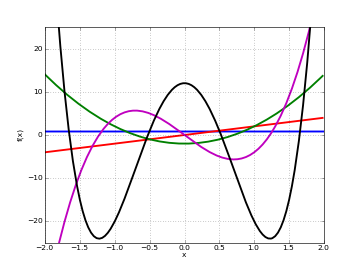
Examples
Evaluation for arbitrary arguments:
>>> from mpmath import * >>> mp.dps = 25; mp.pretty = True >>> hermite(0, 10) 1.0 >>> hermite(1, 10); hermite(2, 10) 20.0 398.0 >>> hermite(10000, 2) 4.950440066552087387515653e+19334 >>> hermite(3, -10**8) -7999999999999998800000000.0 >>> hermite(-3, -10**8) 1.675159751729877682920301e+4342944819032534 >>> hermite(2+3j, -1+2j) (-0.07652130602993513389421901 - 0.1084662449961914580276007j)
Coefficients of the first few Hermite polynomials are:
>>> for n in range(7): ... chop(taylor(lambda z: hermite(n, z), 0, n)) ... [1.0] [0.0, 2.0] [-2.0, 0.0, 4.0] [0.0, -12.0, 0.0, 8.0] [12.0, 0.0, -48.0, 0.0, 16.0] [0.0, 120.0, 0.0, -160.0, 0.0, 32.0] [-120.0, 0.0, 720.0, 0.0, -480.0, 0.0, 64.0]
Values at
 :
:>>> for n in range(-5, 9): ... hermite(n, 0) ... 0.02769459142039868792653387 0.08333333333333333333333333 0.2215567313631895034122709 0.5 0.8862269254527580136490837 1.0 0.0 -2.0 0.0 12.0 0.0 -120.0 0.0 1680.0
Hermite functions satisfy the differential equation:
>>> n = 4 >>> f = lambda z: hermite(n, z) >>> z = 1.5 >>> chop(diff(f,z,2) - 2*z*diff(f,z) + 2*n*f(z)) 0.0
Verifying orthogonality:
>>> chop(quad(lambda t: hermite(2,t)*hermite(4,t)*exp(-t**2), [-inf,inf])) 0.0
Laguerre polynomials¶
laguerre()¶
- mpmath.laguerre(n, a, z)¶
Gives the generalized (associated) Laguerre polynomial, defined by

With
 and
and  a nonnegative integer, this reduces to an ordinary
Laguerre polynomial, the sequence of which begins
a nonnegative integer, this reduces to an ordinary
Laguerre polynomial, the sequence of which begins
 .
.The Laguerre polynomials are orthogonal with respect to the weight
 on
on  .
.Plots
# Hermite polynomials L_n(x) on the real line for n=0,1,2,3,4 f0 = lambda x: laguerre(0,0,x) f1 = lambda x: laguerre(1,0,x) f2 = lambda x: laguerre(2,0,x) f3 = lambda x: laguerre(3,0,x) f4 = lambda x: laguerre(4,0,x) plot([f0,f1,f2,f3,f4],[0,10],[-10,10])
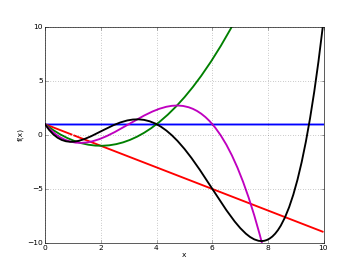
Examples
Evaluation for arbitrary arguments:
>>> from mpmath import * >>> mp.dps = 25; mp.pretty = True >>> laguerre(5, 0, 0.25) 0.03726399739583333333333333 >>> laguerre(1+j, 0.5, 2+3j) (4.474921610704496808379097 - 11.02058050372068958069241j) >>> laguerre(2, 0, 10000) 49980001.0 >>> laguerre(2.5, 0, 10000) -9.327764910194842158583189e+4328
The first few Laguerre polynomials, normalized to have integer coefficients:
>>> for n in range(7): ... chop(taylor(lambda z: fac(n)*laguerre(n, 0, z), 0, n)) ... [1.0] [1.0, -1.0] [2.0, -4.0, 1.0] [6.0, -18.0, 9.0, -1.0] [24.0, -96.0, 72.0, -16.0, 1.0] [120.0, -600.0, 600.0, -200.0, 25.0, -1.0] [720.0, -4320.0, 5400.0, -2400.0, 450.0, -36.0, 1.0]
Verifying orthogonality:
>>> Lm = lambda t: laguerre(m,a,t) >>> Ln = lambda t: laguerre(n,a,t) >>> a, n, m = 2.5, 2, 3 >>> chop(quad(lambda t: exp(-t)*t**a*Lm(t)*Ln(t), [0,inf])) 0.0
Spherical harmonics¶
spherharm()¶
- mpmath.spherharm(l, m, theta, phi)¶
Evaluates the spherical harmonic
 ,
,
where
 is an associated Legendre function (see legenp()).
is an associated Legendre function (see legenp()).Here
![\theta \in [0, \pi]](../_images/math/2881d0a92b53eb5568e81d2c74ea8ade94faa9fe.png) denotes the polar coordinate (ranging
from the north pole to the south pole) and
denotes the polar coordinate (ranging
from the north pole to the south pole) and ![\phi \in [0, 2 \pi]](../_images/math/c7371cd9a7326bd7e49ea7b4e35c8a84f40c76da.png) denotes the
azimuthal coordinate on a sphere. Care should be used since many different
conventions for spherical coordinate variables are used.
denotes the
azimuthal coordinate on a sphere. Care should be used since many different
conventions for spherical coordinate variables are used.Usually spherical harmonics are considered for
 ,
,
 ,
,  . More generally,
. More generally,  are permitted to be complex numbers.
are permitted to be complex numbers.Note
spherharm() returns a complex number, even the value is purely real.
Plots
# Real part of spherical harmonic Y_(4,0)(theta,phi) def Y(l,m): def g(theta,phi): R = abs(fp.re(fp.spherharm(l,m,theta,phi))) x = R*fp.cos(phi)*fp.sin(theta) y = R*fp.sin(phi)*fp.sin(theta) z = R*fp.cos(theta) return [x,y,z] return g fp.splot(Y(4,0), [0,fp.pi], [0,2*fp.pi], points=300) # fp.splot(Y(4,0), [0,fp.pi], [0,2*fp.pi], points=300) # fp.splot(Y(4,1), [0,fp.pi], [0,2*fp.pi], points=300) # fp.splot(Y(4,2), [0,fp.pi], [0,2*fp.pi], points=300) # fp.splot(Y(4,3), [0,fp.pi], [0,2*fp.pi], points=300)
 :
: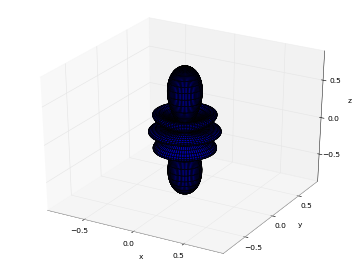
 :
: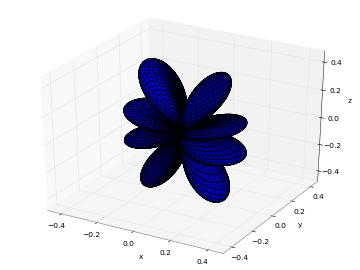
 :
: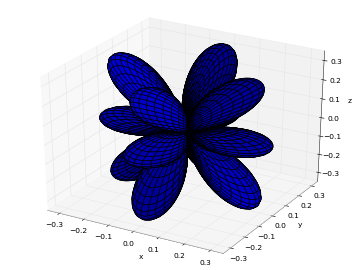
 :
: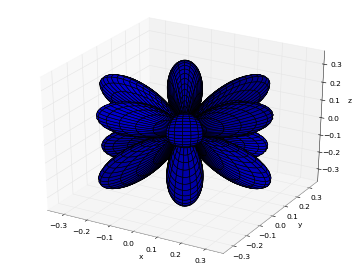
 :
: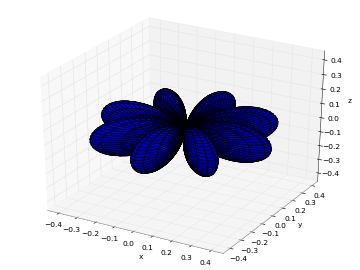
Examples
Some low-order spherical harmonics with reference values:
>>> from mpmath import * >>> mp.dps = 25; mp.pretty = True >>> theta = pi/4 >>> phi = pi/3 >>> spherharm(0,0,theta,phi); 0.5*sqrt(1/pi)*expj(0) (0.2820947917738781434740397 + 0.0j) (0.2820947917738781434740397 + 0.0j) >>> spherharm(1,-1,theta,phi); 0.5*sqrt(3/(2*pi))*expj(-phi)*sin(theta) (0.1221506279757299803965962 - 0.2115710938304086076055298j) (0.1221506279757299803965962 - 0.2115710938304086076055298j) >>> spherharm(1,0,theta,phi); 0.5*sqrt(3/pi)*cos(theta)*expj(0) (0.3454941494713354792652446 + 0.0j) (0.3454941494713354792652446 + 0.0j) >>> spherharm(1,1,theta,phi); -0.5*sqrt(3/(2*pi))*expj(phi)*sin(theta) (-0.1221506279757299803965962 - 0.2115710938304086076055298j) (-0.1221506279757299803965962 - 0.2115710938304086076055298j)
With the normalization convention used, the spherical harmonics are orthonormal on the unit sphere:
>>> sphere = [0,pi], [0,2*pi] >>> dS = lambda t,p: fp.sin(t) # differential element >>> Y1 = lambda t,p: fp.spherharm(l1,m1,t,p) >>> Y2 = lambda t,p: fp.conj(fp.spherharm(l2,m2,t,p)) >>> l1 = l2 = 3; m1 = m2 = 2 >>> print(fp.quad(lambda t,p: Y1(t,p)*Y2(t,p)*dS(t,p), *sphere)) (1+0j) >>> m2 = 1 # m1 != m2 >>> print(fp.chop(fp.quad(lambda t,p: Y1(t,p)*Y2(t,p)*dS(t,p), *sphere))) 0.0
Evaluation is accurate for large orders:
>>> spherharm(1000,750,0.5,0.25) (3.776445785304252879026585e-102 - 5.82441278771834794493484e-102j)
Evaluation works with complex parameter values:
>>> spherharm(1+j, 2j, 2+3j, -0.5j) (64.44922331113759992154992 + 1981.693919841408089681743j)